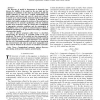96 search results - page 3 / 20 » Motif statistics |
160
click to vote
BMCBI
2005
14 years 12 months ago
2005
Background: Synthetic lethality experiments identify pairs of genes with complementary function. More direct functional associations (for example greater probability of membership...
104
click to vote
TCBB
2010
14 years 6 months ago
2010
Abstract-The discovery of motifs in biosequences is frequently torn between the rigidity of the model on the one hand and the abundance of candidates on the other. In particular, m...
BMCBI
2007
15 years 1 days ago
2007
Background: Predicting the suppression activity of antisense oligonucleotide sequences is the main goal of the rational design of nucleic acids. To create an effective predictive ...
109
click to vote
WABI
2010
Springer
14 years 10 months ago
2010
Springer
Quantification of selective pressures on regulatory sequences is a central question in studying the evolution of gene regulatory networks. Previous methods focus primarily on sing...
BMCBI
2007
15 years 1 days ago
2007
Background: False occurrences of functional motifs in protein sequences can be considered as random events due solely to the sequence composition of a proteome. Here we use a nume...

